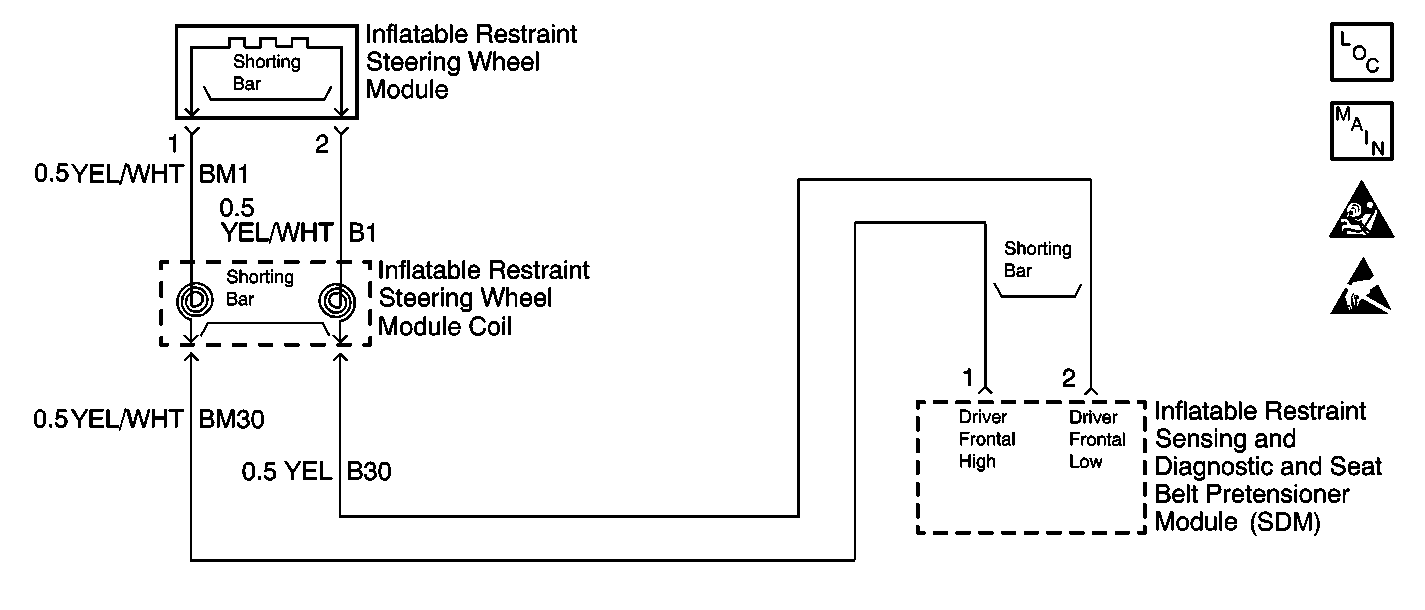
Circuit Description
When the ignition switch is turned to the ON position, the inflatable restraint sensing and diagnostic and seat belt pretensioner module (SDM) performs tests to diagnose critical malfunctions within itself. The SDM monitors the six deployment loops to detect leakage currents to B+ in the frontal air bag deployment loops, the side air bag deployment loops and the seat belt pretensioner deployment loops. Then, the SDM proceeds with the RESISTANCE MEASUREMENT test to measure the deployment loop resistances to ensure they are within their respective normal resistance ranges. Upon passing these tests, the energy reserve is charged and the firing transistors are tested. The SDM then goes into CONTINUOUS MONITORING mode. The SDM service wait time is 1 minute. Refer to ENABLE/DISABLE procedures.
Conditions for Setting the DTC
| • | The ignition is within normal operating voltage range. |
| • | The measured leakage currents to voltage are above a specified value caused by a short to voltage in the driver frontal air bag deployment loop. |
Action Taken When the DTC Sets
| • | The SDM sets a DTC 15. |
| • | The SDM turns ON the AIR BAG warning lamp. |
Conditions for Clearing the DTC
Current and History DTC codes must be cleared using a scan tool Clear DTC Information command. If the circuit fault has been successfully repaired and the conditions which caused the Current DTC 15 to set are no longer present, History DTC 15 will set. History DTC 15 may be cleared using the scan tool.
Diagnostic Aids
A short to voltage in the driver frontal air bag deployment loop can cause an intermittent condition. Inspect CKT BM30 and CKT B30 carefully for cutting and/or chafing. A careful inspection of the circuits and components indicated on the DTC 15 Table is essential to make sure that the replacement SDM will not be damaged. Also inspect CKT BM1 and CKT B1 carefully for cutting and/or chafing.
Test Description
The numbers below refer to step numbers on the diagnostic table.
-
This step checks to see if the inflatable restraint steering wheel module coil is defective.
-
This step checks for a short to B+ in CKT BM30.
-
This step determines if there is a short to B+ in CKT B30 or if there is a malfunctioning SDM.
Step | Action | Value(s) | Yes | No |
|---|---|---|---|---|
1 | Was the SIR Diagnostic System Check performed? | -- | ||
Is DTC 15 current? | -- | |||
3 |
Is the repair complete? | -- | -- | |
| -- | |||
5 |
Is the repair complete? | -- | -- | |
Are the SDM wiring harness connector terminals damaged or corroded? | -- | |||
7 | Use the J 42250 Catera Terminal Repair Kit to repair the SDM wiring harness connector. Is the repair complete? | -- | -- | |
8 | Check for a proper connection at terminal 1 and terminal 2 of the SDM. Are the SDM terminals damaged or corroded? | -- | ||
9 | Check for a proper connection at terminal 1 and terminal 2 of the SDM. Are the SDM terminals damaged or corroded? | -- | ||
10 | Replace the SDM. Refer to Inflatable Restraint Sensing and Diagnostic and Seat Belt Pretensioner Module Replacement . Is the repair complete? | -- | -- | |
Is the measured voltage more than the specified value? | 1 V | |||
12 |
Is the repair complete? | -- | -- | |
Use the J 39200 Digital Multimeter (DMM) to measure the voltage between terminal 2 of the SDM wiring harness connector and a known good ground. Is the measured voltage more than the specified value? | 1 V | |||
14 |
Is the repair complete? | -- | -- | |
15 | Reconnect all the SIR components, making sure all the components are properly mounted. Have all SIR components been reconnected and properly mounted? | -- | -- | |
16 | Use the scan tool to clear all current and history SIR DTCs. Have all current and history SIR DTCs been cleared? | -- | -- |
